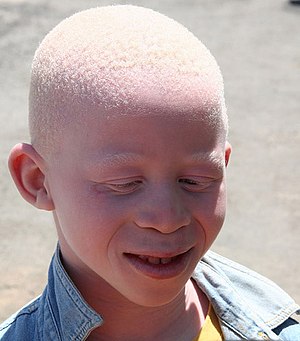Albinism in humans is a congenital disorder characterized by the complete or partial absence of pigment in the skin, hair and eyes. Albinism is associated with a number of vision defects, such as photophobia, nystagmus, and amblyopia. Lack of skin pigmentation makes for more susceptibility to sunburn and skin cancers. In rare cases such as Chédiak–Higashi syndrome,
albinism may be associated with deficiencies in the transportation of
melanin granules. This also affects essential granules present in immune
cells leading to increased susceptibility to infection.
Albinism results from inheritance of recessive gene alleles and is known to affect all vertebrates, including humans. It is due to absence or defect of tyrosinase, a copper-containing enzyme involved in the production of melanin. It is the opposite of melanism. Unlike humans, other animals have multiple pigments and for these, albinism is considered to be a hereditary condition characterised by the absence of melanin in particular, in the eyes, skin, hair, scales, feathers or cuticle.
While an organism with complete absence of melanin is called an albino an organism with only a diminished amount of melanin is described as leucistic or albinoid. The term is from the Latin albus, "white".
In humans, there are two principal types of albinism: oculocutaneous, affecting the eyes, skin and hair, and ocular affecting the eyes only.
Most people with oculocutaneous albinism appear white or very pale, as the melanin pigments responsible for brown, black, and some yellow colorations are not present. Ocular albinism results in light blue eyes, and may require genetic testing to diagnose.
Because individuals with albinism have skin that entirely lacks the dark pigment melanin, which helps protect the skin from the sun's ultraviolet radiation, their skin can burn more easily from overexposure.
Albinism results from inheritance of recessive gene alleles and is known to affect all vertebrates, including humans. It is due to absence or defect of tyrosinase, a copper-containing enzyme involved in the production of melanin. It is the opposite of melanism. Unlike humans, other animals have multiple pigments and for these, albinism is considered to be a hereditary condition characterised by the absence of melanin in particular, in the eyes, skin, hair, scales, feathers or cuticle.
While an organism with complete absence of melanin is called an albino an organism with only a diminished amount of melanin is described as leucistic or albinoid. The term is from the Latin albus, "white".
In humans, there are two principal types of albinism: oculocutaneous, affecting the eyes, skin and hair, and ocular affecting the eyes only.
Most people with oculocutaneous albinism appear white or very pale, as the melanin pigments responsible for brown, black, and some yellow colorations are not present. Ocular albinism results in light blue eyes, and may require genetic testing to diagnose.
Because individuals with albinism have skin that entirely lacks the dark pigment melanin, which helps protect the skin from the sun's ultraviolet radiation, their skin can burn more easily from overexposure.

0 comments:
Post a Comment